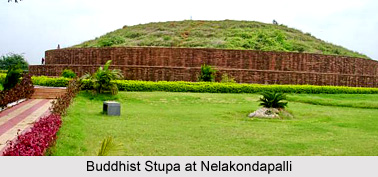 Nelakondapalli, located in Khammam district of Andhra Pradesh, is a historic town. The place is encircled by a mud fortification wall which covers an area of almost 100 acres. Archaeological excavations have also been carried out at Nelakondapalli which have furnished various artefacts such as a Mahastupa, cisterns, wells, brick built Viharas, terracotta figurines etc. A miniature limestone carved Stupa and a bronze idol of Lord Buddha have also been recovered. Most of the artefacts found here belong to third and fourth centuries. Near Nelakondapalli two other significant archaeological sites known as Keechaka Gundam and Virataraju Dibba are situated which claim their association with the period of Mahabharata. Various relics found here also signify the fact that these places were of much significance during the days of Mahabharata.
Nelakondapalli, located in Khammam district of Andhra Pradesh, is a historic town. The place is encircled by a mud fortification wall which covers an area of almost 100 acres. Archaeological excavations have also been carried out at Nelakondapalli which have furnished various artefacts such as a Mahastupa, cisterns, wells, brick built Viharas, terracotta figurines etc. A miniature limestone carved Stupa and a bronze idol of Lord Buddha have also been recovered. Most of the artefacts found here belong to third and fourth centuries. Near Nelakondapalli two other significant archaeological sites known as Keechaka Gundam and Virataraju Dibba are situated which claim their association with the period of Mahabharata. Various relics found here also signify the fact that these places were of much significance during the days of Mahabharata.
Temples at Nelakondapalli
Nelakondapalli houses a number of ancient temples which includes two Vaishnava temples and three Shiva temples. Grand and unique celebration of the festival of Dussehra can be witnessed in the town which invites a number of devotees from nearby towns and villages. Bhaktaramadas Dhyana Mandiram, a meditation centre, hosts the celebration of Ramnavami in collaboration with Bhadrachalam Sri Rama temple and the local villagers. Celebration of Sri Bhaktha Ramadas memorial festival is an important event in Nelakondapalli which is observed between 28 April and 2 May every year.
Bhakta Ramadas Memorial Building
Nelakondapalli is also the birthplace of famed 17th-century Indian devotee of Rama and Carnatic music composer Bhakta Ramadas, also known as Kancherla Gopanna. At his birthplace, Bhakta Ramadas Memorial Building was established in the year 1955 which was later renamed as Bhakta Ramadasu Dhyana Mandiram. In 1983, it was handed over to Sri Seeteramachandra Swamy Devastanam, Badrachalam, for the development of the same.
This article is a stub. You can enrich by adding more information to it. Send your Write Up to content@indianetzone.com



















